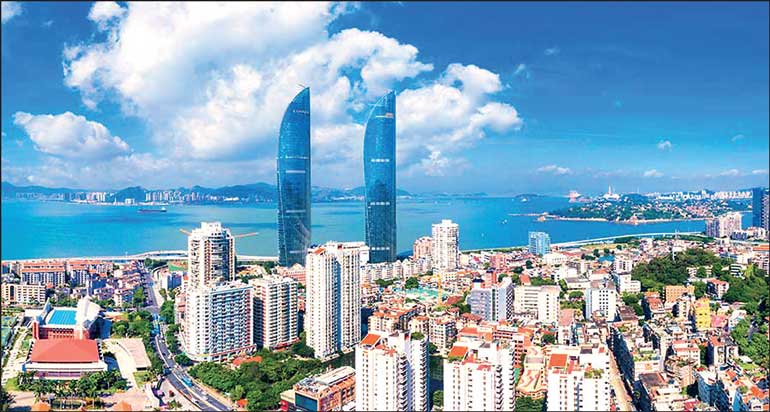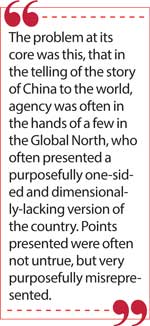Tuesday Jan 13, 2026
Tuesday Jan 13, 2026
Friday, 1 March 2024 00:24 - - {{hitsCtrl.values.hits}}

China appears to continue doing what it does best – move forward. And this perspective, whether for China, or any other country of the Global South, remains vital
 A debt trap. A dispute at sea. A trade threat. An anomaly. A friend of Russia. The many names China has been called in recent years doesn’t require much reiteration, because they are already so engrained in our minds; either by label-repetition, international media-unison and perhaps also because of China’s Achilles’ heels – limitations with the English language and Western expression.
A debt trap. A dispute at sea. A trade threat. An anomaly. A friend of Russia. The many names China has been called in recent years doesn’t require much reiteration, because they are already so engrained in our minds; either by label-repetition, international media-unison and perhaps also because of China’s Achilles’ heels – limitations with the English language and Western expression.
Meeting with Chinese counterparts over the last month, I only had one question. Why don’t they fight the provocation much harder? And moreover fight it in public spaces rather than behind closed diplomatic doors where the risk for facts to be eluded and stereotypes resorted to being much higher. A case in point is perhaps the blatant press leaks to a closed door diplomatic meeting at the G20; a clear unapologetic breach of pacta sunt servanda.
The problem at its core was this, that in the telling of the story of China to the world, agency was often in the hands of a few in the Global North, who often presented a purposefully one-sided and dimensionally-lacking version of the country. Points presented were often not untrue, but very purposefully misrepresented. How could they be okay with this? The answers I received can only be described as profound at best.
My interlocutors, not privy to the Western critical lens that perhaps I myself am victim to, would not waste our meeting on West-bashing. Instead what I found was understanding rooted in respect toward counterparts – regardless of whatever part of the world those counterparts were from, and an assured confidence that in this game of story telling, that time, would ultimately tell the most truthful story.
The interactions, to a great extent quantify the cultural tapestry that makes up Chinese characteristics to development; where Sri Lanka may have a five-year plan and Switzerland may have a 25-year plan, China sees the future in millennia. But is China correct to believe that the fullness of its story will be told, without urgency in the here and now for that correction to be forced? It begs the question of what the status quo is on that story being retold. There are some indicators that can be looked at for this purpose.
Redefining ‘made-in-China’
For one thing the connotation of what ‘made-in-China’ means is changing at accelerating velocity. The Chinese automobile manufacturer BYD for instance is viewed as the company to beat when it comes to transport-decarbonisation. Neck-to-neck and often ahead of companies such as Tesla. And while general publics are unaware of BYD’s presence around the world, the company is credited with the tech and manufacturing of electric buses that run in over 70 countries, including the iconic double decker buses that run in London. Its technological lead in lithium iron phosphate (LFP) batteries, has caused other EV manufacturers around the globe to up their game, with BYD ranking 212 on the 2023 Fortune Global 500 list, ascending 224 positions within a year, making it the fastest-growing Chinese company on the list.
Following behind in battery R & D, is CATL, another Chinese manufacturer which offers nearly every battery type made by BYD, and also collaborates with Western brands that have become synonymous in consumers’ minds with luxury and dependability; BMW, Ford and Toyota to name a few. Chinese companies have long viewed such collaborations and partnerships with pride, both out of recognition of its own achievements and that of foreign partners, but there appears to be hesitance on the part of Western counterparts to generally cite Chinese tech and recognise that beneath the cover of what looks intrinsically Western, is made-in-China products and tech. With the rise of companies like BYD this is bound to change, one informed consumer at a time.
Green economies
 Electronic Vehicles however are only one part of China’s move toward green technologies. It’s estimated that the country is actively promoting green and low-carbon transformation more fiercely that European or American counterparts, with energy transition investments reaching around $ 546 billion in 2022, about four times more than that of the United States. What’s interesting about the Chinese model, is that the economic advancements that come hand-in-hand with such policies, aren’t limited for China’s reaping alone. For instance Kristalina Georgieva, Managing Director of the IMF recently noted that a 1% increase in China’s economic growth contributes to around a 0.3% increase in productivity for other Asian economies. The percentages and data assist to better understand why Western narratives and cultural provocations rarely fracture China’s bilateral relations with global south countries.
Electronic Vehicles however are only one part of China’s move toward green technologies. It’s estimated that the country is actively promoting green and low-carbon transformation more fiercely that European or American counterparts, with energy transition investments reaching around $ 546 billion in 2022, about four times more than that of the United States. What’s interesting about the Chinese model, is that the economic advancements that come hand-in-hand with such policies, aren’t limited for China’s reaping alone. For instance Kristalina Georgieva, Managing Director of the IMF recently noted that a 1% increase in China’s economic growth contributes to around a 0.3% increase in productivity for other Asian economies. The percentages and data assist to better understand why Western narratives and cultural provocations rarely fracture China’s bilateral relations with global south countries.
But perhaps because production and manufacturing output has always been part of how the world views China, it may be important to also assess the other areas in which the country is active, yet not globally recognised, or is still misrepresented.
Conflict mediation
In the last year the country has shown that it is serious about its role as a mediator in conflict resolution, not only with the Ukraine-Russia conflict but also within the context of Iran and Saudi Arabia. Even French President Macron noted that his Chinese counterpart had shared ‘important words’ on the Ukraine crisis, and expressed his belief that China could play a major role in finding a path to peace. Its efforts last year in brokering a peace deal between Iran and Saudi Arabia could have ushered in stability to regions including Iraq, Syria, Lebanon, Yemen and Bahrain, had the severe escalation of tensions not taken place in Gaza. China’s emphasis on negotiation and peaceful coexistence is part and parcel of its historic cultural expression; for instance, with its observer status within the Non Aligned Movement, the country has maintained strong links with the organisation, alongside NAM’s founding pillars being almost identical to the 5 principles of peaceful coexistence contained in the Panchsheel, a 1954 codification of the Chinese government’s foreign relations principles.
Conclusion: Perspective matters
The areas of work mentioned in this article are significant to understand what China really is, yet somehow, international publicity of it remains scarce or lacking all together. Whether or not mass international media will move past political ideology and the one-size-fits-all measurement in this sense, is yet to be seen. But China appears to continue doing what it does best – move forward. And this perspective, whether for China, or any other country of the Global South, remains vital.
(The writer holds a double Masters in International Law & Human Rights from the United Nations-mandated University for Peace in Costa Rica, and in Political Science with a major in Global Governance from Ateneo de Manila University in the Philippines. She has worked as a specialist in public diplomacy for Sri Lanka and US governments and has been responsible for creating initiatives toward building South-South cooperation between Global South entities. She is the Founder and convener of Perspective South an international platform for public accessibility to geopolitics, international law terminology, and perspectives of the Global South. She works part-time as a post-grad lecturer in International Law. In the past, she has operated as a fixer and researcher for the NY Times, Swedish Public Media (SVT) and the Finnish Broadcasting Company (YLE). She is currently based in Colombo.)